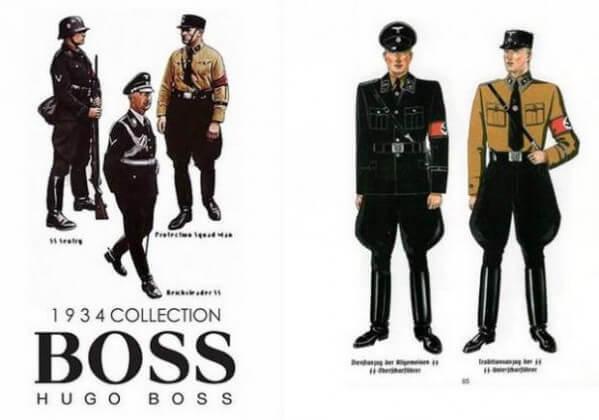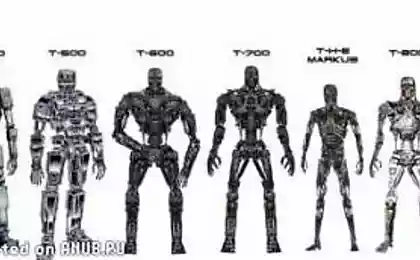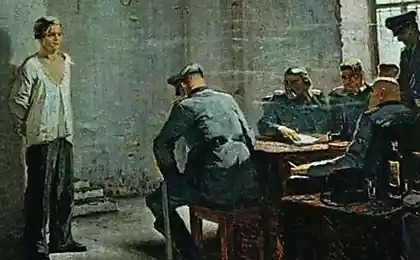253
Famous global brands that collaborated with fascists
On July 1, 1948, an American military tribunal found the Friedrich Krupp concern guilty of using slave labor and plundering industrial enterprises of other countries. Its head, Alfrid Felix Alvin Krupp von Bohlen und Galbach, was sentenced to 12 years in prison with confiscation of property for collaborating with the Nazis. Krupp was not alone in collaborating with the Nazis; they also had other well-paid assistants (unfortunately, not all of them deserved punishment).

For people interested in this topic, it is no secret that the real history of the Second World War is impossible without highlighting the fact that Hitler was well-sponsored by international corporations. Through the strings of banking and industrial corporations in Western Europe and the United States, fascist Germany received huge sums of money to expand its activities. Civilized Europe and America are now carefully erasing from the history of World War II these shameful facts of their cooperation with the bloodiest and most inhumane regime of the twentieth century, but their "civilization" owes it.
Many people have their own knowledge of the corporations that collaborated with the Nazis. However, these were not the only companies that colluded with the Nazis—other global business entities still recognizable today also sold their souls to the devil in various ways—and you might be surprised to see some of the names listed below.
So, what famous world giants are caught in close ties with Hitler’s Germany?
Krupp.

Existing almost a century and a half concern began with the production of seamless railway wheels (this was indicated by its emblem: three intertwined rings). Already in the First World War, the position of Krupp was simple: to earn as much as possible in the war and the company devoted all its potential to serving the needs of the army - guns, ammunition, new types of weapons.
Nothing changed the concept of the concern with the coming to power of the fascists, at that time peacefully producing agricultural machinery, but prudently having since the First world a couple of artillery plants transported to Sweden, with a full staff of designers and other valuable personnel. "Krupp" becomes the main executor of military orders of Hitler's Germany, quickly producing tanks, self-propelled artillery, infantry trucks, reconnaissance cars.
Although by the decision of the Yalta and Postdam Conference, the concern was subject to complete destruction, it was reborn as a phoenix bird - already in 1951 Krupp was released and his entire fortune was returned to him. Alfrid Krupp took over the management of the company and achieved the cancellation of the resolution on the liquidation of the concern. Two decades later, the staff of the company reached 100 thousand employees!
In 1999, Krupp merged with the second German giant Thyssen AG and is now the brainchild of ThyssenKrupp AG, the world’s leading steel producer. And who now remembers the pages of the history of the concern stained by cooperation with the Hitlerites?
Ikea

Among the richest entrepreneurs in the world are people who have devoted their youth to membership in nationalist parties. In 1994, letters from Swedish fascist activist Per Endal revealed that the legendary founder of Ikea, Ingvar Kamprad, was a member of a pro-Nazi organization from 1942 to 1945. He collected donations for the party and even after leaving it, he sold off communication with former colleagues. Ingvar Kamprad later confirmed the accuracy of this information and said that he bitterly regrets this episode of his biography. In a letter to Ikea employees, he apologized to Jews.
Metro Metro Metro
The founder of the Metro Group, Otto Baysheim, served in an elite unit of the SS, the Leibstandart Adolf Hitler, which was under the personal patronage of Adolf Hitler. Members of the Leibstandart served as personal guards of the highest ranks of the Third Reich. Baisheim is considered one of the most closed businessmen.
“As far as I know, some corporations pay compensation to victims of fascism. The Nuremberg trial took place and the perpetrators were convicted. I do not know whether a “tribunal” is needed for corporations that aided fascism, but such facts, of course, should be made public, said Olga Abramenko, director of the St. Petersburg charitable historical and educational human rights organization Memorial. Consumers have every right to ignore the products of such companies.
For aiding fascism convicted businessman Hugo Ferdinand Boss, the founder of the famous design brand, on the eve of the war owned a small workshop for sewing workwear. The enterprise was on the verge of collapse, and then enterprising Hugo joined the NSDAP to be able to receive military orders. By 1939, the company became the main supplier of military uniforms for the Wehrmacht. The Boss did not shy away from using forced labor of prisoners of war. Hugo Boss was recognized as an accomplice of Nazism, sentenced to a fine of 80,000 Deutschmarks and deprived of the right to vote for the rest of his life.
Adidas and Puma

Brothers Adolf and Rudolf Dassler, founders of brands Adidas and Puma, were staunch supporters of Nazism, members of the NSDAP, Rudolf even went to the front.
Reproaches in the past periodically overtake the founder of L’Oreal Eugene Schuller. The media claimed that he helped the Nazi organization La Cagoule.
Chase Bank If you think about it, Chase Bank’s (now J.P. Morgan Chase) collusion with the Nazis isn’t all that surprising. One of its main shareholders, J. D. Rockefeller, directly financed the pre-war eugenics experiments of the Nazis. Between 1936 and 1941, Chase and other U.S. banks helped the Germans raise more than $20 million in dollar terms, earning more than $1.2 million in commissions – of which Chase pocketed a round half million.
That was a lot of money at the time. The fact that the German stamps aimed at financing the operation had their source in Jews fleeing Nazi Germany did not seem to bother Chase – in fact, the bank corrected itself after Kristallnacht (a night in 1938 during which Jews throughout Nazi Germany and Austria were subjected to targeted pogroms). Chase also froze the accounts of French Jews in occupied France before the Nazis even thought about asking him to.
It is worth adding that a wider range of banks were actually involved in the Nazi case. But those who lit up (Chase) were only the “exhaust pipe”.
Ford

Henry Ford receives one of Nazi Germany’s highest honors, the Iron Eagle, from high-ranking officials in 1938.
Henry Ford was himself a notorious anti-Semite who published a collection of articles under the enchanting title International Jewry. The original world problem.” Ford even sponsored his own newspaper, which he used as an element of propaganda, accusing Jews of World War I, and in 1938 received the Order of Merit of the German Eagle, the highest insignia of Nazi Germany, which was awarded to foreign citizens.
Ford produced a third of the military trucks for the German army during the war, with the widespread use of prisoners. What’s even more shocking is that Ford may have been using forced labor as far back as 1940, when the company’s U.S. division was still in full control.
Random House
You may not have heard of Bertelsmann A.G., but you will hear about books published by many of its subsidiaries, including Random House, Bantam Books and Doubleday. During the Nazi period, Bertelsmann published Nazi propaganda literature, such as Sterilization and Ephthanasia: Contributions to Applied Christian Ethics.
She even unveiled the works of Willie Vesper, who gave an enthusiastic speech at the 1933 book burning. In 1997, Random House was at the center of another debate about Nazism, when it added “a person fanatically devoted to certain activities, practices, etc. or the desire to master them” to the definition of “Nazi” in Webster’s dictionary, prompting the Anti-Defamation League to make a statement that the publisher “downplays and denies the bloodthirsty intent and actions of the Nazi regime.”
Kodak When you think of Kodak, you immediately see idyllic family photos and filmed memories, but what you should really keep in mind is the forced labor that was used in the German branch of the firm during World War II.
Kodak’s subsidiaries in neutral European countries did brisk business with the Nazis, providing them with both a market for their goods and valuable foreign exchange. The Portuguese unit even transferred its profits to the unit in The Hague, which was then under Nazi occupation. Moreover, this company was not only engaged in the manufacture of cameras - it mastered the production of fuses, detonators and other military products for the Germans.
Coca-Cola

Fanta is an orange-flavored drink originally conceived for the Nazis. Rightly so, importing the ingredients for Coca-Cola, which gives the brand its name, was difficult, so Max Kite, the head of Coca-Cola’s division in Germany, invented a new drink that could be made from affordable ingredients.
In 1941, Fanta debuted on the German market. McKite was not a Nazi himself, but his efforts to keep Coca-Cola's unit running smoothly throughout the war meant that the company made a fortune and could return to distributing Coca-Cola to American soldiers stationed in Europe with the end of the war.
Allianz

The leaders of the new economy. From left to right Darre, Walter Funk (Head of the Economic Policy Commission), Kurt Schmitt (Minister of Economy) and Gottfried Feder (State Secretary of the Ministry of Economy)
Allianz is the twelfth largest financial services company in the world. Unsurprisingly, having been founded in 1890 in Germany, it was Germany’s largest insurer when the Nazis came to power. As such, it quickly became involved with the Nazi regime. Its head Kurt Schmitt was also Hitler’s Minister of Economy, and the company provided insurance for Auschwitz facilities and personnel.
Its general director is responsible for the practice of paying insurance compensation for Jewish property destroyed in Kristallnacht to the Nazi state instead of eligible beneficiaries. In addition, the company worked closely with the Nazi state to track the life insurance policies of German Jews sent to death camps, and during the war insured for the Nazis property taken from the same Jewish population.
Novartis Although Bayer is notorious for starting out as a unit of the Zyklon B gas producer used by the Nazis in gas chambers, it is not the only pharmaceutical company with skeletons in its closet. Swiss chemical companies Ciba and Sandoz as a result of the merger formed Novartis, famous primarily for its drug Ritalin (a scandalous psychostimulant widely used in the United States for the treatment of childhood hyperactivity; approx. mixednews).
In 1933, the Berlin branch of Ciba terminated all members of its board of directors of Jewish nationality and replaced them with more "acceptable" Aryan cadres; meanwhile, Sandoz was engaged in similar activities towards its chairman. During the war, companies produced dyes, medicines and chemicals for the Nazis. Novartis frankly confessed to her guilt and tried to make amends in a way typical of other accomplices - donating $ 15 million to the Swiss fund for compensation to victims of Nazism.
Nestle In 2000, Nestle paid more than $14.5 million to the fund in connection with its use of slave labor to settle claims of victims and Holocaust survivors, as well as Jewish organizations.
The firm admitted that in 1947 it acquired a company that used forced labor during the war, and also stated: “There is no doubt, or it can be assumed that some corporations of the Nestlé group operating in countries controlled by the National Socialist (Nazi) regime exploited forced laborers.” In 1939, Nestlé provided financial aid to the Nazi party in Switzerland, winning a lucrative contract to supply chocolate to the German army during World War II.
BMW BMW admitted to using 30,000 unskilled forced laborers during the war. These prisoners of war, forced laborers, and concentration camp inmates produced engines for the Luftwaffe and were thus forced to help the regime protect itself from those who tried to save them. During the war, BMW concentrated exclusively on the production of airplanes and motorcycles, pretending to be nothing more than a supplier of military vehicles to the Nazis.
Maggi Maggi was founded in 1872 in Switzerland by Julius Maggi. The entrepreneur was the first to appear on the market with ready-made soups. In 1897, Julius Maggi founded Maggi GmbH in the German city of Singen, where it is still based today. The rise to power of the Nazis had little impact on business. In the 1930s, the company became a supplier of semi-finished products for German troops.
Given that none of the management of the organization was not noticed in a particularly active political life, the brand has retained itself and continues to please. This time also the former Soviet Union.
Nivea. The history of the Nivea brand dates back to 1890, when a businessman named Oscar Troplowitz bought the company "Beiersdorf" from its founder.
In the 1930s, the brand positioned itself as a commodity for active life and sports. The main products were protective creams and razors. During the Second World War, the advertising part of the brand was responsible for Ellie Hayes Knapp, who became the first lady under Theodore Hayes. According to her, in her advertising campaigns, she tried to bypass the militaristic component, emphasizing the display of active life in peaceful circumstances. However, sports smiling girls from Nivea posters could inspire the Wehrmacht fighters no less, if not better than the mustachioed face of Hitler from NSDAP posters.
It is noteworthy that during the war, several countries at war with Germany appropriated trademark rights. The process of buying rights by Beiersdorf was completed only in 1997.
General Electric In 1946, the U.S. government fined General Electric for wartime misconduct. Together with Krupp, a German industrial company, General Electric deliberately overpriced tungsten carbide, which is a vital material for the machining of metals needed for frontline needs.
However, having been fined a total of $ 36,000, General Electric alone made about a million and a half dollars on this fraud, thereby preventing mobilization and increasing the cost of defeating Nazism. GE also bought a stake in Siemens before the war broke out, making itself an accomplice in the use of slave labor to build the very gas chambers where many sick workers ended up.
Hugo Boss

Hugo founded his company in 1923, when Germany was in a state of economic collapse. In 1931 he joined the Nazi Party. He received an order for the manufacture of uniforms for the German armed forces, stormtroopers, SS men and the youth organization Hitler-Jugend.
The SS and Wehrmacht uniform developed by Hugo was the best in the history of military uniforms. He did not speak of the superiority of Germany. These were the clothes of the army of the future. Wherever German soldiers appeared, from the snowy shores of Norway to the deserts of Africa, they were seen as conquerors of the world.
After World War II, Hugo Boss was recognized as an accomplice of Hitler, and his company had to pay a fine of 80,000 marks. He died in 1948 and the factory was run by his children and grandchildren.
Needless to say, in addition to the world’s large firms, most of the well-known German companies (Siemens, Volkswagen, etc.) actively cooperated with the Nazis, receiving lucrative contracts and free labor, consisting of prisoners of concentration camps, ghettos, prisoners of war and forced export from the occupied territories. Unhappy people, who were kept worse than cattle, often worked to death in the factories of unscrupulous companies, seeking to enrich themselves at any cost. published
Read also:
Why all nations raised babies in a hanging cradle
The Crom of the North: the history of the knife, which is 10 thousand years old
P.S. And remember, just changing our consumption – together we change the world!
Join us on Facebook, VKontakte, Odnoklassniki
Source: moiarussia.ru/tesnyj-kontakt-kakie-izvestnye-mirovye-brendy-sotrudnichali-s-fashistami/

For people interested in this topic, it is no secret that the real history of the Second World War is impossible without highlighting the fact that Hitler was well-sponsored by international corporations. Through the strings of banking and industrial corporations in Western Europe and the United States, fascist Germany received huge sums of money to expand its activities. Civilized Europe and America are now carefully erasing from the history of World War II these shameful facts of their cooperation with the bloodiest and most inhumane regime of the twentieth century, but their "civilization" owes it.
Many people have their own knowledge of the corporations that collaborated with the Nazis. However, these were not the only companies that colluded with the Nazis—other global business entities still recognizable today also sold their souls to the devil in various ways—and you might be surprised to see some of the names listed below.
So, what famous world giants are caught in close ties with Hitler’s Germany?
Krupp.

Existing almost a century and a half concern began with the production of seamless railway wheels (this was indicated by its emblem: three intertwined rings). Already in the First World War, the position of Krupp was simple: to earn as much as possible in the war and the company devoted all its potential to serving the needs of the army - guns, ammunition, new types of weapons.
Nothing changed the concept of the concern with the coming to power of the fascists, at that time peacefully producing agricultural machinery, but prudently having since the First world a couple of artillery plants transported to Sweden, with a full staff of designers and other valuable personnel. "Krupp" becomes the main executor of military orders of Hitler's Germany, quickly producing tanks, self-propelled artillery, infantry trucks, reconnaissance cars.
Although by the decision of the Yalta and Postdam Conference, the concern was subject to complete destruction, it was reborn as a phoenix bird - already in 1951 Krupp was released and his entire fortune was returned to him. Alfrid Krupp took over the management of the company and achieved the cancellation of the resolution on the liquidation of the concern. Two decades later, the staff of the company reached 100 thousand employees!
In 1999, Krupp merged with the second German giant Thyssen AG and is now the brainchild of ThyssenKrupp AG, the world’s leading steel producer. And who now remembers the pages of the history of the concern stained by cooperation with the Hitlerites?
Ikea

Among the richest entrepreneurs in the world are people who have devoted their youth to membership in nationalist parties. In 1994, letters from Swedish fascist activist Per Endal revealed that the legendary founder of Ikea, Ingvar Kamprad, was a member of a pro-Nazi organization from 1942 to 1945. He collected donations for the party and even after leaving it, he sold off communication with former colleagues. Ingvar Kamprad later confirmed the accuracy of this information and said that he bitterly regrets this episode of his biography. In a letter to Ikea employees, he apologized to Jews.
Metro Metro Metro

The founder of the Metro Group, Otto Baysheim, served in an elite unit of the SS, the Leibstandart Adolf Hitler, which was under the personal patronage of Adolf Hitler. Members of the Leibstandart served as personal guards of the highest ranks of the Third Reich. Baisheim is considered one of the most closed businessmen.
“As far as I know, some corporations pay compensation to victims of fascism. The Nuremberg trial took place and the perpetrators were convicted. I do not know whether a “tribunal” is needed for corporations that aided fascism, but such facts, of course, should be made public, said Olga Abramenko, director of the St. Petersburg charitable historical and educational human rights organization Memorial. Consumers have every right to ignore the products of such companies.
For aiding fascism convicted businessman Hugo Ferdinand Boss, the founder of the famous design brand, on the eve of the war owned a small workshop for sewing workwear. The enterprise was on the verge of collapse, and then enterprising Hugo joined the NSDAP to be able to receive military orders. By 1939, the company became the main supplier of military uniforms for the Wehrmacht. The Boss did not shy away from using forced labor of prisoners of war. Hugo Boss was recognized as an accomplice of Nazism, sentenced to a fine of 80,000 Deutschmarks and deprived of the right to vote for the rest of his life.
Adidas and Puma

Brothers Adolf and Rudolf Dassler, founders of brands Adidas and Puma, were staunch supporters of Nazism, members of the NSDAP, Rudolf even went to the front.
Reproaches in the past periodically overtake the founder of L’Oreal Eugene Schuller. The media claimed that he helped the Nazi organization La Cagoule.
Chase Bank If you think about it, Chase Bank’s (now J.P. Morgan Chase) collusion with the Nazis isn’t all that surprising. One of its main shareholders, J. D. Rockefeller, directly financed the pre-war eugenics experiments of the Nazis. Between 1936 and 1941, Chase and other U.S. banks helped the Germans raise more than $20 million in dollar terms, earning more than $1.2 million in commissions – of which Chase pocketed a round half million.
That was a lot of money at the time. The fact that the German stamps aimed at financing the operation had their source in Jews fleeing Nazi Germany did not seem to bother Chase – in fact, the bank corrected itself after Kristallnacht (a night in 1938 during which Jews throughout Nazi Germany and Austria were subjected to targeted pogroms). Chase also froze the accounts of French Jews in occupied France before the Nazis even thought about asking him to.
It is worth adding that a wider range of banks were actually involved in the Nazi case. But those who lit up (Chase) were only the “exhaust pipe”.
Ford

Henry Ford receives one of Nazi Germany’s highest honors, the Iron Eagle, from high-ranking officials in 1938.
Henry Ford was himself a notorious anti-Semite who published a collection of articles under the enchanting title International Jewry. The original world problem.” Ford even sponsored his own newspaper, which he used as an element of propaganda, accusing Jews of World War I, and in 1938 received the Order of Merit of the German Eagle, the highest insignia of Nazi Germany, which was awarded to foreign citizens.
Ford produced a third of the military trucks for the German army during the war, with the widespread use of prisoners. What’s even more shocking is that Ford may have been using forced labor as far back as 1940, when the company’s U.S. division was still in full control.
Random House
You may not have heard of Bertelsmann A.G., but you will hear about books published by many of its subsidiaries, including Random House, Bantam Books and Doubleday. During the Nazi period, Bertelsmann published Nazi propaganda literature, such as Sterilization and Ephthanasia: Contributions to Applied Christian Ethics.
She even unveiled the works of Willie Vesper, who gave an enthusiastic speech at the 1933 book burning. In 1997, Random House was at the center of another debate about Nazism, when it added “a person fanatically devoted to certain activities, practices, etc. or the desire to master them” to the definition of “Nazi” in Webster’s dictionary, prompting the Anti-Defamation League to make a statement that the publisher “downplays and denies the bloodthirsty intent and actions of the Nazi regime.”
Kodak When you think of Kodak, you immediately see idyllic family photos and filmed memories, but what you should really keep in mind is the forced labor that was used in the German branch of the firm during World War II.
Kodak’s subsidiaries in neutral European countries did brisk business with the Nazis, providing them with both a market for their goods and valuable foreign exchange. The Portuguese unit even transferred its profits to the unit in The Hague, which was then under Nazi occupation. Moreover, this company was not only engaged in the manufacture of cameras - it mastered the production of fuses, detonators and other military products for the Germans.
Coca-Cola

Fanta is an orange-flavored drink originally conceived for the Nazis. Rightly so, importing the ingredients for Coca-Cola, which gives the brand its name, was difficult, so Max Kite, the head of Coca-Cola’s division in Germany, invented a new drink that could be made from affordable ingredients.
In 1941, Fanta debuted on the German market. McKite was not a Nazi himself, but his efforts to keep Coca-Cola's unit running smoothly throughout the war meant that the company made a fortune and could return to distributing Coca-Cola to American soldiers stationed in Europe with the end of the war.
Allianz

The leaders of the new economy. From left to right Darre, Walter Funk (Head of the Economic Policy Commission), Kurt Schmitt (Minister of Economy) and Gottfried Feder (State Secretary of the Ministry of Economy)
Allianz is the twelfth largest financial services company in the world. Unsurprisingly, having been founded in 1890 in Germany, it was Germany’s largest insurer when the Nazis came to power. As such, it quickly became involved with the Nazi regime. Its head Kurt Schmitt was also Hitler’s Minister of Economy, and the company provided insurance for Auschwitz facilities and personnel.
Its general director is responsible for the practice of paying insurance compensation for Jewish property destroyed in Kristallnacht to the Nazi state instead of eligible beneficiaries. In addition, the company worked closely with the Nazi state to track the life insurance policies of German Jews sent to death camps, and during the war insured for the Nazis property taken from the same Jewish population.
Novartis Although Bayer is notorious for starting out as a unit of the Zyklon B gas producer used by the Nazis in gas chambers, it is not the only pharmaceutical company with skeletons in its closet. Swiss chemical companies Ciba and Sandoz as a result of the merger formed Novartis, famous primarily for its drug Ritalin (a scandalous psychostimulant widely used in the United States for the treatment of childhood hyperactivity; approx. mixednews).
In 1933, the Berlin branch of Ciba terminated all members of its board of directors of Jewish nationality and replaced them with more "acceptable" Aryan cadres; meanwhile, Sandoz was engaged in similar activities towards its chairman. During the war, companies produced dyes, medicines and chemicals for the Nazis. Novartis frankly confessed to her guilt and tried to make amends in a way typical of other accomplices - donating $ 15 million to the Swiss fund for compensation to victims of Nazism.
Nestle In 2000, Nestle paid more than $14.5 million to the fund in connection with its use of slave labor to settle claims of victims and Holocaust survivors, as well as Jewish organizations.
The firm admitted that in 1947 it acquired a company that used forced labor during the war, and also stated: “There is no doubt, or it can be assumed that some corporations of the Nestlé group operating in countries controlled by the National Socialist (Nazi) regime exploited forced laborers.” In 1939, Nestlé provided financial aid to the Nazi party in Switzerland, winning a lucrative contract to supply chocolate to the German army during World War II.
BMW BMW admitted to using 30,000 unskilled forced laborers during the war. These prisoners of war, forced laborers, and concentration camp inmates produced engines for the Luftwaffe and were thus forced to help the regime protect itself from those who tried to save them. During the war, BMW concentrated exclusively on the production of airplanes and motorcycles, pretending to be nothing more than a supplier of military vehicles to the Nazis.
Maggi Maggi was founded in 1872 in Switzerland by Julius Maggi. The entrepreneur was the first to appear on the market with ready-made soups. In 1897, Julius Maggi founded Maggi GmbH in the German city of Singen, where it is still based today. The rise to power of the Nazis had little impact on business. In the 1930s, the company became a supplier of semi-finished products for German troops.
Given that none of the management of the organization was not noticed in a particularly active political life, the brand has retained itself and continues to please. This time also the former Soviet Union.
Nivea. The history of the Nivea brand dates back to 1890, when a businessman named Oscar Troplowitz bought the company "Beiersdorf" from its founder.
In the 1930s, the brand positioned itself as a commodity for active life and sports. The main products were protective creams and razors. During the Second World War, the advertising part of the brand was responsible for Ellie Hayes Knapp, who became the first lady under Theodore Hayes. According to her, in her advertising campaigns, she tried to bypass the militaristic component, emphasizing the display of active life in peaceful circumstances. However, sports smiling girls from Nivea posters could inspire the Wehrmacht fighters no less, if not better than the mustachioed face of Hitler from NSDAP posters.
It is noteworthy that during the war, several countries at war with Germany appropriated trademark rights. The process of buying rights by Beiersdorf was completed only in 1997.
General Electric In 1946, the U.S. government fined General Electric for wartime misconduct. Together with Krupp, a German industrial company, General Electric deliberately overpriced tungsten carbide, which is a vital material for the machining of metals needed for frontline needs.
However, having been fined a total of $ 36,000, General Electric alone made about a million and a half dollars on this fraud, thereby preventing mobilization and increasing the cost of defeating Nazism. GE also bought a stake in Siemens before the war broke out, making itself an accomplice in the use of slave labor to build the very gas chambers where many sick workers ended up.
Hugo Boss

Hugo founded his company in 1923, when Germany was in a state of economic collapse. In 1931 he joined the Nazi Party. He received an order for the manufacture of uniforms for the German armed forces, stormtroopers, SS men and the youth organization Hitler-Jugend.
The SS and Wehrmacht uniform developed by Hugo was the best in the history of military uniforms. He did not speak of the superiority of Germany. These were the clothes of the army of the future. Wherever German soldiers appeared, from the snowy shores of Norway to the deserts of Africa, they were seen as conquerors of the world.
After World War II, Hugo Boss was recognized as an accomplice of Hitler, and his company had to pay a fine of 80,000 marks. He died in 1948 and the factory was run by his children and grandchildren.
Needless to say, in addition to the world’s large firms, most of the well-known German companies (Siemens, Volkswagen, etc.) actively cooperated with the Nazis, receiving lucrative contracts and free labor, consisting of prisoners of concentration camps, ghettos, prisoners of war and forced export from the occupied territories. Unhappy people, who were kept worse than cattle, often worked to death in the factories of unscrupulous companies, seeking to enrich themselves at any cost. published
Read also:
Why all nations raised babies in a hanging cradle
The Crom of the North: the history of the knife, which is 10 thousand years old
P.S. And remember, just changing our consumption – together we change the world!
Join us on Facebook, VKontakte, Odnoklassniki
Source: moiarussia.ru/tesnyj-kontakt-kakie-izvestnye-mirovye-brendy-sotrudnichali-s-fashistami/
Hydrogen sedan and wagon from Riversimple
Rare color photographs of the Russian Empire in the early 20th century























